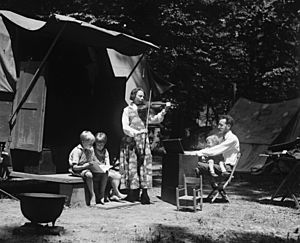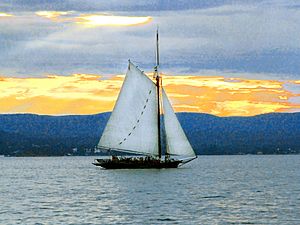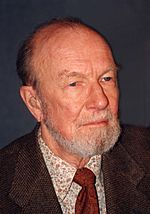Pete Seeger facts for kids
Quick facts for kids Pete Seeger |
|
|---|---|
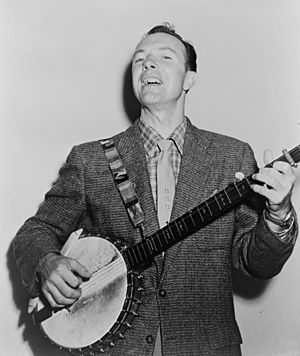
Seeger playing the banjo in 1955
|
|
| Background information | |
| Birth name | Peter Seeger |
| Born | May 3, 1919 New York City, U.S. |
| Died | January 27, 2014 (aged 94) New York City, U.S. |
| Genres |
|
| Occupation(s) |
|
| Instruments |
|
| Years active | 1939–2014 |
| Labels | |
| Associated acts |
|
| Military career | |
| Allegiance | |
| Branch | |
| Years of service | 1942–1945 |
| Rank | |
| Unit | |
| Battles/wars | World War II |
| Awards |
|
Pete Seeger (born May 3, 1919 – died January 27, 2014) was an American folk singer and activist. He was famous on the radio in the 1940s. In the early 1950s, he had many hit songs as part of the Weavers. Their song "Goodnight, Irene" was number one for 13 weeks in 1950.
Later, in the 1960s, Seeger became a well-known singer of protest songs. He sang about important topics like civil rights, protecting the environment, and peace.
Pete Seeger wrote many famous songs. Some of his best-known songs include "Where Have All the Flowers Gone?", "If I Had a Hammer", and "Turn! Turn! Turn!". Many other artists have recorded his songs. For example, "If I Had a Hammer" was a hit for Peter, Paul and Mary.
Seeger also helped make the spiritual song "We Shall Overcome" popular. This song became a very important anthem for the Civil Rights Movement. Pete Seeger said he changed the words from "We will overcome" to "We shall overcome" to make it easier to sing.
Contents
Pete Seeger: A Folk Music Hero
Early Life and Family
Pete Seeger was born in New York City on May 3, 1919. His family had a long history in America. They were very religious.
Pete's father, Charles Seeger, was a composer and music expert. He helped start the study of musicology in the United States. Pete's mother, Constance de Clyver Seeger, was a talented violinist. She also taught music at the Juilliard School.
When Pete was seven, his parents divorced. His father later married Ruth Crawford Seeger, who was also a famous composer. Pete had many half-siblings who also became folk singers. His sister Peggy Seeger and brother Mike Seeger were well-known performers.
Discovering Music
Pete Seeger started boarding school at age four. He later attended schools in Nyack, New York, and Ridgefield, Connecticut. Even though his parents were classical musicians, they didn't push him to play an instrument.
Pete found his own way to music. He started playing the ukulele and loved to entertain his classmates. This helped him connect with audiences later on.
Learning the Banjo
In 1936, when Pete was 17, he heard the five-string banjo for the first time. This happened at a music festival in North Carolina. He was deeply impressed by the sound. He spent the next four years learning to play the banjo.
Pete also visited the home of painter Thomas Hart Benton. There, he heard many traditional American folk songs. These experiences shaped his love for folk music.
Early Career and Activism
Pete Seeger went to Harvard University for a while. But he became more interested in politics and folk music. He left college in 1938. His first music job was teaching folk singing at the Dalton School.
He also worked at the Library of Congress. There, he helped Alan Lomax collect American folk songs. Seeger soon started performing on a radio show called Back Where I Come From. He sang alongside famous musicians like Woody Guthrie and Lead Belly. This show was special because it had both Black and white performers.
Serving in the Army
From 1942 to 1945, Pete Seeger served in the United States Army during World War II. He was trained to fix airplanes. But he was later asked to entertain the troops with his music. When people asked what he did in the war, he would say, "I strummed my banjo."
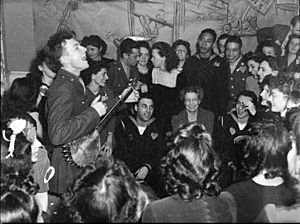
Singing for Change
In the spring of 1941, Pete Seeger joined a group called the Almanac Singers. This group included Woody Guthrie and Lee Hays. They sang songs about important issues of the day. Their music supported workers' rights and racial equality.
The Almanac Singers recorded albums like Songs for John Doe and Talking Union. Their songs often shared messages about fairness and justice.
The Weavers and Challenges
In 1950, the Almanac Singers became the Weavers. This group included Pete Seeger, Lee Hays, Ronnie Gilbert, and Fred Hellerman. They sang about workers' struggles and other progressive ideas.
The Weavers had many hit songs. Their version of "Goodnight, Irene" was a huge success. Other hits included "On Top of Old Smoky" and "Wimoweh".
Facing Difficult Times
In the 1950s, during a time called the McCarthy Era, many artists were "blacklisted". This meant they were unfairly stopped from working because of their political beliefs. The Weavers were also blacklisted. Radio stations stopped playing their music, and their concerts were canceled.
Pete Seeger was called to testify before the House Un-American Activities Committee (HUAC) in 1955. He refused to answer questions about his personal beliefs or who his friends were. He believed this was against his First Amendment rights to free speech. Because of this, he faced legal trouble, but his conviction was later overturned.
Despite these challenges, Seeger continued to make music. He taught music in schools and at summer camps. He also recorded many albums for Folkways Records.
Folk Music Revival and Impact
In the late 1950s and early 1960s, Pete Seeger's anti-war songs became very popular. Songs like "Where Have All the Flowers Gone?" and "Turn! Turn! Turn!" were sung by many people.
Seeger was also a strong supporter of the Civil Rights Movement. In 1963, he helped organize a concert to support the Highlander Research and Education Center. He sang "We Shall Overcome" during the historic march from Selma to Montgomery, Alabama.
A Mentor to Others
Pete Seeger was a very important figure in the folk music scene. He helped many new folk singers, including Bob Dylan. He encouraged Dylan and invited him to perform at the Newport Folk Festival.
Environmental Activism
Pete Seeger was also passionate about protecting the environment. In 1966, he and his wife, Toshi, started the Hudson River Sloop Clearwater. This group works to protect the Hudson River and its waterways. They built a special boat, the sloop Clearwater, to help teach people about environmental issues. They also started an annual music and environmental festival.
Later Years and Legacy
Pete Seeger continued to be active in music and activism throughout his life. He performed with many artists, including Bruce Springsteen. In 2009, he sang "This Land Is Your Land" with Springsteen at Barack Obama's presidential concert.
Seeger passed away on January 27, 2014, at the age of 94. President Barack Obama called him "America's tuning fork." He said Seeger believed in "the power of song" to bring about social change. Many other musicians and activists shared how much Pete Seeger had inspired them.
Pete Seeger's Instruments
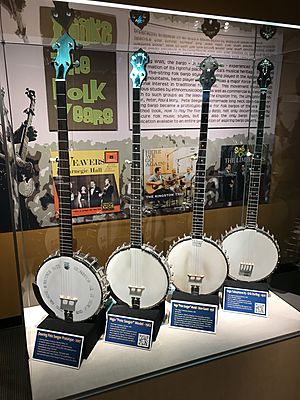
In 1948, Pete Seeger wrote a famous book called How to Play the Five-String Banjo. This book taught many people how to play the instrument. He also invented the long-neck or Seeger banjo. This banjo is longer than a regular one and can play lower notes. Thanks to Seeger, the five-string banjo became known as a key American folk instrument.
From the late 1950s, Seeger also played the 12-string guitar. This type of guitar was often played by Lead Belly, another famous folk musician.
Awards and Recognition
Pete Seeger received many awards for his music and activism. Some of these include:
- Induction into the Songwriters Hall of Fame (1972)
- The Grammy Lifetime Achievement Award (1993)
- The National Medal of Arts (1994)
- Kennedy Center Honors (1994)
- Induction into the Rock and Roll Hall of Fame (1996)
- A Grammy Award for Best Traditional Folk Album for his album Pete (1997)
- The Felix Varela Medal from Cuba for his work against racism and for the environment (1999)
- A Grammy Award for Best Traditional Folk Album for At 89 (2009)
- A Grammy Award for Best Musical Album for Children for Tomorrow's Children (2011)
- The Woody Guthrie Prize (2014)
In 2022, the United States Postal Service even issued a special Pete Seeger stamp!
Discography
- American Folk Songs for Children (1953)
- American Industrial Ballads (1956)
- American Favorite Ballads, Vol. 2 (1958)
- Gazette, Vol. 1 (1958)
- Sleep-Time: Songs & Stories (1958)
- God Bless the Grass (1966)
- Dangerous Songs!? (1966)
- Rainbow Race (1973)
- American Folk Songs for Children (1990)
- At 89 (2008)
See also
 In Spanish: Pete Seeger para niños
In Spanish: Pete Seeger para niños
- List of banjo players
- List of peace activists
- Tom Winslow – Clearwater singer and songwriter
- Union Boys


